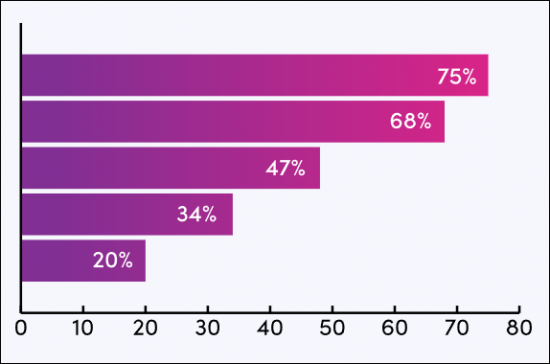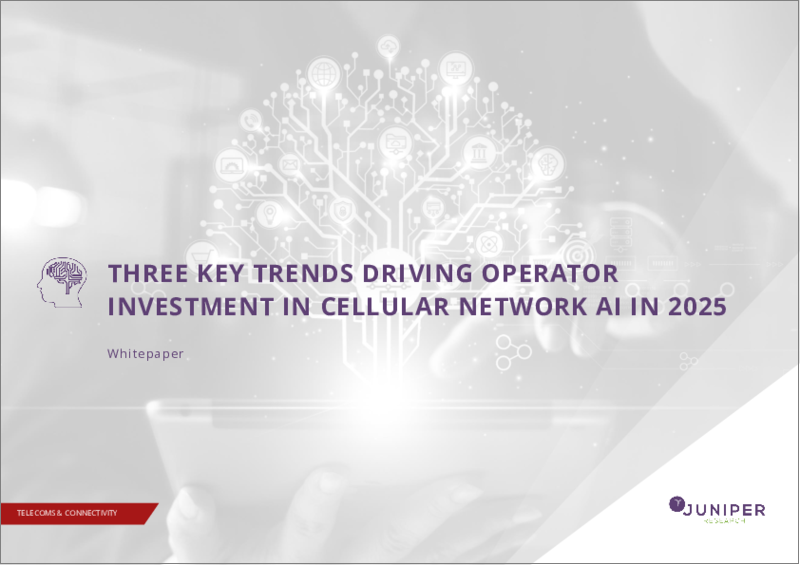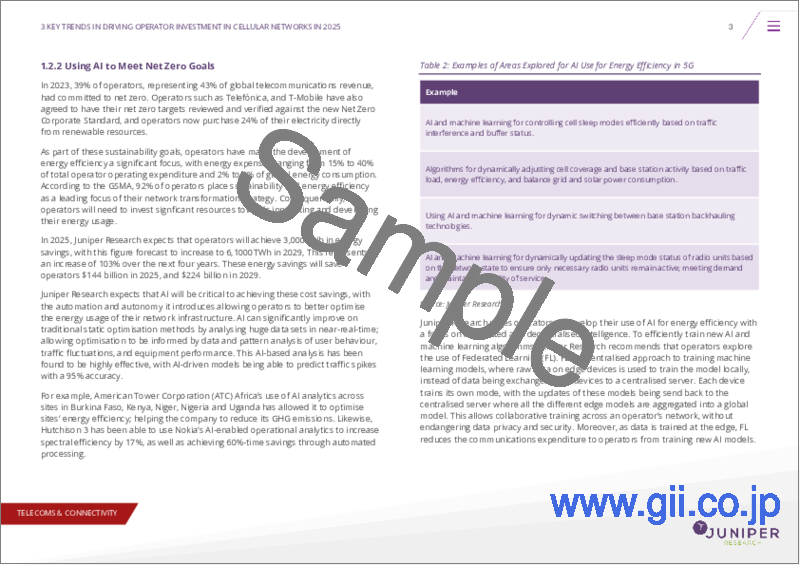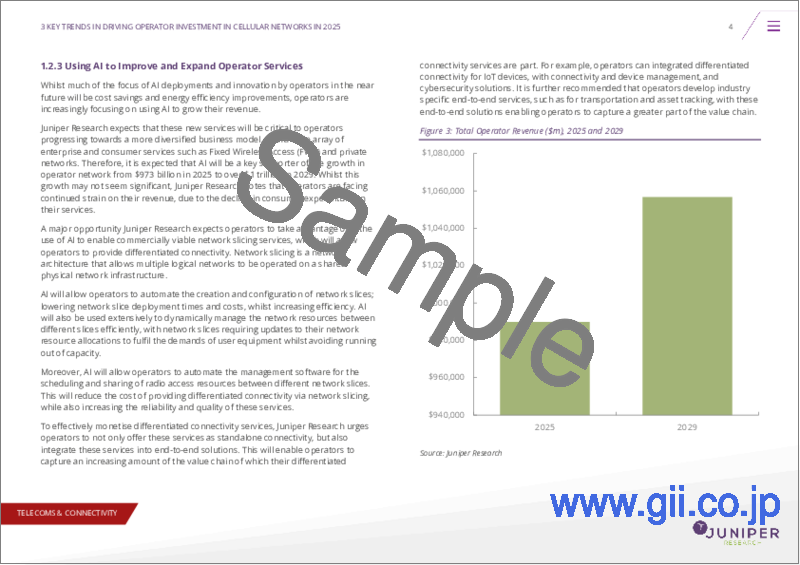|
|
市場調査レポート
商品コード
1698611
セルラーネットワークにおけるAIの世界市場:2025-2029年Global AI in Cellular Networks Market: 2025-2029 |
||||||
|
|||||||
| セルラーネットワークにおけるAIの世界市場:2025-2029年 |
|
出版日: 2025年04月07日
発行: Juniper Research Ltd
ページ情報: 英文
納期: 即日から翌営業日
|
全表示
- 概要
- 目次
"ゼロタッチ"が焦点となり、通信事業者のAI投資は今後4年間で860億米ドルを超える見通し
| 主要統計 | |
|---|---|
| 2025年のセルラーネットワークにおける通信事業者のAI投資額: | 135億米ドル |
| 2029年のセルラーネットワークにおける通信事業者のAI投資額: | 229億米ドル |
| 通信事業者のデジタルトランスフォーメーションへの投資額: | 1,080億米ドル |
| 予測期間: | 2025-2029年 |
当調査スイートは、通信事業者とネットワークAIベンダーに分析と実用的な洞察を提供します。また、移動体通信事業者 (MNO) やネットワークAIベンダーなどの市場のステークホルダーが、ネットワークにおけるAIへの関与に関する事業戦略について十分な情報に基づいた意思決定を行うためのデータも含まれています。本調査では、通信事業者のセルラーネットワークにおけるAI導入に関する8つのケーススタディに加え、Indosat Ooredoo HutchisonのAI-RAN戦略に関するケーススタディを掲載しています。これらのケーススタディには以下が含まれます:
|
|
|
これらのケーススタディでは、大手通信事業者がネットワークにAIをどのように導入し、どのように革新しているか、その導入と革新の中核的な強みについて分析し、これらの導入が将来的にその通信事業者をどのように位置づけるかを評価しています。これにより、他の通信事業者やネットワークAIベンダーは、市場の最先端を行く事業者がネットワークAIにどのように取り組んでいるかを理解し、情報に基づいた意思決定や戦略策定を支援することができます。
本調査スイートには、通信事業者のネットワークAI導入の主な目標の内訳も含まれており、これらの目標が将来どのように進化すると予想しているかの分析も行っています。これに加えて、無線アクセスネットワーク (RAN) におけるAI、AI-RANアライアンス、水平RANスタックの開発、ソブリンAI、ネットワーク計画におけるAI、ネットワーク保守におけるAI、ネットワークスライシングと差別化接続におけるAIなど、主要な概念や技術の戦略的分析も行っています。
さらに、通信事業者がAIを活用してネットワークセキュリティを向上させる方法、詐欺師や悪意ある行為者から自社のAI導入を保護する方法、事業者がデータセンターとクラウドインフラでAIの影響を最大化する方法に関する戦略的分析に関する提言と評価を提供しています。これにより、通信事業者、ネットワークAIベンダー、その他のステークホルダーは、AI導入のさまざまな領域について効果的に評価し、十分な情報に基づいたビジネス上の意思決定を行うことができます。
このほか、本レポートでは、エージェント型AI、TeleManagement (TM) フォーラムの自律型ネットワーク、6G、大規模言語モデル (LLM) 、GSMAのOpen-Telco LLMベンチマークなどの技術や標準についての知見も提供しています。各セクションでは、Juniper Researchによる提言や分析とともに、主要動向の理解に加え、将来の研究開発の機会と戦略を明らかにしています。
主な特徴
- 市場力学:AI-RANアライアンスによるAI-RANの開発、ソブリンAIの役割、ネットワークセキュリティにおけるAIの利用方法、通信事業者のAIユースケースの進展など、セルラーネットワークにおけるAI市場の主な動向と機会に関する洞察、大手通信事業者8社のネットワークにおけるAIの活用に関する戦略的分析、各通信事業者の導入事例や投資について掲載しています。
- 主な要点と戦略的提言:セルラーネットワークにおけるAI市場における主な開発機会や知見を詳細に分析し、収益の拡大や製品提供の優位性を得ようとする通信事業者やAIネットワークベンダーに対する戦略的提言を掲載しています。
- ベンチマーク業界予測:SIM総数、通信事業者の収益、通信事業者のデジタルトランスフォーメーションへの投資総額、通信事業者のAIへの投資総額、通信事業者のネットワークAIへの投資総額のデータを提供します。ネットワークAIへの総事業者投資額は、RAN向けネットワークAIへの総事業者投資額、オーケストレーションと管理向けネットワークAIへの総事業者投資額、ネットワークセキュリティ向けネットワークAIへの総事業者投資額、運用・保守 (O&M) 向けネットワークAIへの総事業者投資額を分割して提供しています。
- Juniper ResearchのFuture Leaders' Index:ネットワークAIベンダー16社の能力を評価し、各ベンダーの市場規模と詳細な分析結果を掲載しています。
サンプルビュー
市場データ・予測

市場データ・予測
本調査スイートには、7,900以上のデータポイントからなる予測データ一式へのアクセスが含まれています。調査スイートには以下の指標が含まれます:
- 通信事業者の総収益
- 通信事業者のデジタルトランスフォーメーションへの投資総額
- 通信事業者のAIへの投資総額
- ネットワークAIへの投資総額
- RAN向けネットワークAIへの通信事業者投資総額
- オーケストレーションおよび管理向けネットワークAIへの通信事業者投資総額
- ネットワーク・セキュリティ向けネットワークAIへの通信事業者投資総額
- 事業者のO&M向けネットワークAIへの投資総額
Juniper Researchのインタラクティブ予測 (Excel) には以下の機能があります:
- 統計分析:データ期間中のすべての地域と国について表示される特定のメトリクスを検索できるのがメリットです。グラフは簡単に変更でき、クリップボードにエクスポートできます。
- 国別データツール:このツールでは、予測期間中のすべての地域と国の指標を見ることができます。検索バーで表示される指標を絞り込むことができます。
- 国別比較ツール:特定の国を選択して比較することができます。このツールには、グラフをエクスポートする機能が含まれています。
- What-if分析:3つのインタラクティブなシナリオを通じて、ユーザーは予測の前提条件と比較することができます。
目次
市場動向・戦略
第1章 重要ポイント・戦略的提言
第2章 市場情勢
- 通信事業者が自社ネットワークにAIを導入しようとしている理由
- AIを活用したネットワークTCOの削減
- AIを活用したネットゼロ目標の達成
- AIを活用したオペレーターサービスの改善・拡大
- 世界の大手通信事業者が自社のネットワークでAIをどのように活用しているか
第3章 主要技術と将来の機会
- ネットワークにおけるAIの主要技術
- エージェントAI
- 6G
- LLM
- AIネットワーク導入の主な機会
- AI RAN
- ネットワークデータセンターとクラウド管理のためのAI
- ネットワークセキュリティのためのAI
- ネットワークメンテナンスのためのAI
- ネットワークプランニングのためのAI
- ネットワークスライシングと差別化された接続のためのAI
競合リーダーボード
第1章 競合リーダーボード
第2章 ベンダープロファイル
- ベンダープロファイル
- Blue Planet
- Cisco
- Ericsson
- Google Cloud
- Huawei
- IBM
- Jio Platforms
- Juniper Networks
- Mavenir
- Microsoft
- Netcracker
- Nokia
- NVIDIA
- Samsung
- Subex
- ZTE
- Juniper Researchリーダーボード評価手法
- 制限と解釈
- 関連調査
データ・予測
第1章 イントロダクション・調査手法
第2章 市場サマリーと今後の市場展望
- オペレーターの総収益
- ネットワークAIへの通信事業者総投資額
- RAN AI向けネットワークAIへの通信事業者総投資額
- ネットワークオーケストレーション・管理向けネットワークAIへの通信事業者総投資額
- ネットワークセキュリティ向けネットワークAIへの通信事業者総投資額
- 運用保守向けネットワークAIへの通信事業者総投資額
'Operator AI Investment to Exceed $86bn Over the Next Four Years as 'Zero Touch' Becomes the Focus'
| KEY STATISTICS | |
|---|---|
| Total operator investment in AI in cellular networks in 2025: | $13.5bn |
| Total operator investment in AI in cellular networks in 2029: | $22.9bn |
| Total operator investment in digital transformation: | $108bn |
| Forecast period: | 2025-2029 |
Overview
Our "AI in Cellular Networks" research suite provides operators and AI in network vendors with analysis and actionable insights. It also includes data which enables stakeholders in the market, such as mobile network operators (MNOs) and network AI vendors, to make informed decisions on business strategy for their involvement with AI in networks. The research suite covers eight case studies into operators' AI in cellular networks deployments, as well as a further case study for Indosat Ooredoo Hutchison's AI-RAN strategy. These case studies include:
|
|
|
Each of these case studies breaks down how a leading operator is deploying and innovating with AI in their networks, with analysis from Juniper Research on the core strengths of their deployments and innovations, and evaluation of how these deployments position the operator in the future. This allows other operators and network AI vendors to understand how those at the forefront of the market are approaching network AI; supporting informed decision-making and strategy formulation.
The research suite also includes a breakdown of the key goals of operators' AI in networks deployments, with analysis of how Juniper Research expects these goals to evolve in the future. This is coupled with strategic analysis of key concepts and technologies, including AI in Radio Access Network (RAN), the AI-RAN Alliance, the development of horizontal RAN stacks, sovereign AI, AI in network planning, AI in network maintenance, and AI in network slicing and differentiated connectivity.
It further provides recommendations and assessments on how operators can use AI to improve their network security, as well as protect their own AI deployments from fraudsters and malicious actors, and strategic analysis of how operators can maximise the impact of AI in their datacentres and cloud infrastructure. Through this, operators, network AI vendors, and other stakeholders can effectively evaluate and make informed business decisions regarding different areas of AI deployments.
As well as this, the report offers insight into technologies and standards including agentic AI, TeleManagement (TM) Forum's Autonomous Networks, 6G, large language model (LLM), and the GSMA's Open-Telco LLM Benchmarks. Accompanied by Juniper Research's recommendations and analysis, each of these sections identifies future development opportunities and strategies, in addition to providing an understanding of key trends.
The market forecast suite includes several different options that can be purchased separately, including access to data mapping and a forecast document, a strategy and trends document detailing critical trends in the market, and strategic recommendations for monetising and innovating AI in cellular networks.
The research suite includes a Competitor Leaderboard, which can be purchased separately; containing analysis and market sizing for 16 leading network AI vendors, who each provide operators with software for AI in network deployments.
Collectively, the suite provides a critical tool for understanding the AI in cellular networks market allowing operators, AI in network vendors, and other stakeholders to optimise their future business and product development strategies for the market; providing a competitive advantage over their rivals.
All report content is delivered in the English language.
Key Features
- Market Dynamics: Insights into the key trends and opportunities within the AI in cellular networks market, including the development of AI-RAN by the AI-RAN Alliance, the role of sovereign AI, how AI is being used in network security, and how operators are progressing their AI use cases. It also includes strategic analysis of eight leading operators' use of AI in their networks, with a case study into each operator's deployments and investments.
- Key Takeaways & Strategic Recommendations: In-depth analysis of key development opportunities and findings within the AI in cellular networks market, accompanied by strategic recommendations for operators and AI in network vendors seeking to grow their revenue or gain an advantage in their product offerings.
- Benchmark Industry Forecasts: The suite provides four-year forecasts for the global AI in cellular networks market; providing data for the total number of SIMs, total operator revenue, total operator investment in digital transformation, total operator investment in AI, and total operator investment in network AI. Total operator investment in network AI is provided with splits for total operator investment in network AI for RAN, total operator investment in network AI for orchestration and management, total operator investment in network AI for network security, and total operator investment in network AI for operations and maintenance (O&M).
- Juniper Research Future Leaders' Index: Key player capability and capacity assessment for 16 AI in networks vendors, with market sizing and detailed analysis for each vendor's offering.
SAMPLE VIEW
Market Data & Forecasts

The numbers tell you what's happening, but our written report details why, alongside the methodologies.
Market Data & Forecasts
The market-leading research suite for the AI in networks market includes access to the full set of forecast data, comprising more than 7,900 datapoints. Metrics in the research suite include:
- Total Operator Revenue
- Total Operator Investment in Digital Transformation
- Total Operator Investment in AI
- Total Operator Investment in Network AI
- Total Operator Investment in Network AI for RAN
- Total Operator Investment in Network AI for Orchestration and Management
- Total Operator Investment in Network AI for Network Security
- Total Operator Investment in Network AI for O&M
Juniper Research's Interactive Forecast Excel contains the following functionality:
- Statistics Analysis: Users benefit from the ability to search for specific metrics, displayed for all regions and countries across the data period. Graphs are easily modified and can be exported to the clipboard.
- Country Data Tool: This tool lets users look at metrics for all regions and countries in the forecast period. Users can refine the metrics displayed via a search bar.
- Country Comparison Tool: Users can select and compare specific countries. The ability to export graphs is included in this tool.
- What-if Analysis: Here, users can compare forecast metrics against their own assumptions, via three interactive scenarios.
Market Trends & Strategies Report
The report thoroughly examines the global "AI in Cellular Networks" market; assessing market trends, technological developments, and commercial opportunities which are shaping the market both in the present and the future. Alongside this analysis, the document includes a comprehensive analysis of the different areas of AI deployment, such as in RAN, datacentre management, and network slicing; with this analysis supporting stakeholders in evaluating how they can separate from their competition and become a market leader.
This innovative ecosystem report also includes a breakdown and evaluation of eight leading operators' investments and deployments for network AI. These case studies allow players in the network AI market to better understand the direction of leaders in the market, in turn providing insight into key trends and a foundation to develop their own business and product or technology development strategies.
Competitor Leaderboard Report
The Competitor Leaderboard included in this report provides detailed evaluation and market positioning for 16 network AI vendors. These key companies are positioned as established leaders, leading challengers, or disruptors and challengers, based on a capacity, capability, and product assessment. This includes analysis of their key advantages in the market, future development plans, and key partnerships.
The AI in Cellular Networks Competitor Leaderboard includes the following key vendors:
|
|
|
Table of Contents
Market Trends & Strategies
1. Key Takeaways Strategic Recommendations
- 1.1. Key Takeaways
- 1.2. Key Strategic Recommendations
2. Market Landscape
- 2.1. Introduction
- Figure 2.1: Total Operator Investment in Network AI ($m), Split By 8 Key Regions, 2024-2029
- 2.1.1. Why Are Operators Seeking to Deploy AI in Their Networks
- 2.1.2. Using AI to Reduce Network TCO
- Figure 2.2: Total Number of 5G Connections (m), Split By 8 Key Regions, 2024-2029
- 2.1.3. Using AI to Meet Net Zero Goals
- Figure 2.3: Total Operator Energy Savings (TWh), Split By 8 Key Regions, 2024-2029
- Table 2.4: Examples of Areas Explored for AI Use for Energy Efficiency in 5G
- 2.1.4. Using AI to Improve and Expand Operator Services
- Figure 2.5: Total Operator Revenue ($m), Split By 8 Key Regions, 2024-2029
- 2.2. How Leading Operators Are Using AI in Their Networks Around the World
3. Key Technologies and Future Opportunities
- 3.1. Key Technologies for AI in Networks
- 3.1.1. Agentic AI
- i. TM Forum's Autonomous Networks
- Figure 3.1: TM Forum's Autonomous Network Levels
- i. TM Forum's Autonomous Networks
- 3.1.2. 6G
- Figure 3.3: 3GPP Timeline and Ericsson Expectations for First Commercial System
- 3.1.3. LLMs
- Figure 3.4: Use Cases for LLMs in Operator Networks
- i. GSMA Open Telco LLM Benchmarks and Custom Operator LLMs
- Table 3.5: Accuracy Comparison Between GPT-3.5, GPT-4, and Active Professionals
- 3.1.1. Agentic AI
- 3.2. Key Opportunities for AI Network Deployments
- 3.2.1. AI RAN
- Figure 3.6: Benefits Expected to be Provided by AI-RAN
- ii. AI Services and Multi-tenant RAN Infrastructure
- Table 3.7: NVIDIA and Softbank's Achievements With AI-RAN as of February 2025
- Figure 3.8: Schematic of Multi-tenant AI RAN Reference Architecture
- Figure 3.9: GPT-4 3-Shot Accuracy on MMLU Languages
- Tables 3.10: Examples of Sovereign AI Initiatives, Investments and Policies
- 3.2.2. AI for Network Datacentre and Cloud Management
- Figure 3.11: Total Operator Expenditure on Cloud ($m), Split by 8 Key Regions, 2023-2028
- 3.2.3. AI for Network Security
- i. Operator Strategies for Using AI to Protect Their Networks
- Figure 3.12: Key Use Cases for AI Security in Cellular Networks
- ii. The Threat of AI to Operator Networks
- i. Operator Strategies for Using AI to Protect Their Networks
- 3.2.4. AI for Network Maintenance
- 3.2.5. AI for Network Planning
- 3.2.6. AI for Network Slicing and Differentiated Connectivity
- Figure 3.13: Key Types of Network Slicing
- 3.2.1. AI RAN
Competitor Leaderboard
1. Competitor Leaderboard
- 1.1. Why Read This Report
- AI Development Must Be Focused on Creating Dynamic Infrastructure and Operations
- Table 1.1: Juniper Research Competitor Leaderboard Vendors and Product Portfolios
- Figure 1.2: Juniper Research Competitor Leaderboard: Network AI Vendors
- Source: Juniper ResearchTable 1.3: Juniper Research Competitor Leaderboard: Network AI Vendors
- Table 1.4: Juniper Research Competitor Leaderboard Heatmap: Network AI Vendors (1 of 2)
- Table 1.5: Juniper Research Competitor Leaderboard Heatmap: Network AI Vendors (2 of 2)
- AI Development Must Be Focused on Creating Dynamic Infrastructure and Operations
2. Vendor Profiles
- 2.1. Vendor Profiles
- 2.1.1. Blue Planet
- i. Corporate Information
- Figure 2.1: Blue Planet Revenue ($m), Financial Year 2023-2024
- ii. Geographical Spread
- iii. Key Clients & Strategic Partnerships
- iv. High-level View of Offerings
- Figure 2.2: Blue Planet 5G Network Planning and Deployment Solution
- v. Juniper Research's View: Key Strengths & Strategic Development Opportunities
- i. Corporate Information
- 2.1.2. Cisco
- i. Corporate Information
- ii. Geographical Spread
- iii. Key Clients & Strategic Partnerships
- iv. High-level View of Offerings
- Figure 2.3: Cisco Crosswork Network Automation Tenets
- v. Juniper Research's View: Key Strengths & Strategic Development Opportunities
- 2.1.3. Ericsson
- i. Corporate Information
- Table 2.4. Ericsson's Financial Information ($m), 2021-2024
- ii. Geographical Spread
- iii. Key Clients & Strategic Partnerships
- iv. High-level View of Offerings
- Figure 2.5: Ericsson Intelligent Automation Platform (EIAP)
- v. Juniper Research's View: Key Strengths & Strategic Development Opportunities
- i. Corporate Information
- 2.1.4. Google Cloud
- i. Corporate Information
- ii. Geographical Spread
- Figure 2.6: Google Cloud Platform Regions
- iii. Key Clients & Strategic Partnerships
- iv. High-level View of Offerings
- v. Juniper Research's View: Key Strengths & Strategic Development Opportunities
- 2.1.5. Huawei
- i. Corporate Information
- ii. Geographical Spread
- iii. Key Clients & Strategic Partnerships
- iv. High-level View of Offerings
- v. Juniper Research's View: Key Strengths & Strategic Development Opportunities
- 2.1.6. IBM
- i. Corporate Information
- Table 2.7: IBM's Select Financial Information ($m), 2021-2023
- ii. Geographical Spread
- Figure 2.8: IBM Datacentre and Machine-readable Zones (MZRs) Location Map
- iii. Key Clients & Strategic Partnerships
- iv. High-level View of Offerings
- Figure 2.9: IBM Cloud Paks for Network Automation
- v. Juniper Research's View: Key Strengths & Strategic Development Opportunities
- i. Corporate Information
- 2.1.7. Jio Platforms
- i. Corporate Information
- ii. Geographical Spread
- iii. Key Clients & Strategic Partnerships
- iv. High-level View of Offerings
- v. Juniper Research's View: Key Strengths & Strategic Development Opportunities
- 2.1.8. Juniper Networks
- i. Corporate Information
- ii. Geographical Spread
- iii. Key Clients & Strategic Partnerships
- iv. High-level View of Offerings
- Figure 2.10: Juniper Networks' O-RAN Offering
- v. Juniper Research's View: Key Strengths & Strategic Development Opportunities
- 2.1.9. Mavenir
- i. Corporate Information
- ii. Geographical Spread
- iii. Key Clients & Strategic Partnerships
- iv. High-level View of Offerings
- Figure 2.11: Mavenir's AI & Analytics Solutions
- v. Juniper Research's View: Key Strengths & Strategic Development Opportunities
- 2.1.10. Microsoft
- i. Corporate Information
- ii. Geographical Spread
- iii. Key Clients & Strategic Partnerships
- iv. High-level View of Offerings
- Figure 2.12: Azure Operator Nexus
- v. Juniper Research's View: Key Strengths & Strategic Development Opportunities
- 2.1.11. Netcracker
- i. Corporate Information
- ii. Geographical Spread
- iii. Key Clients & Strategic Partnerships
- iv. High-level View of Offerings
- Figure 2.13: Netcracker Network Automation Suite
- Figure 2.14: E2E Service and Slice Automation
- Figure 2.15: Network Domain Orchestration
- v. Juniper Research's View: Key Strengths & Strategic Development Opportunities
- 2.1.12. Nokia
- i. Corporate Information
- Table 2.16: Nokia's Select Financial Information ($m), 2021-2024
- ii. Geographical Spread
- iii. Key Clients & Strategic Partnerships
- iv. High-level View of Offerings
- v. Juniper Research's View: Key Strengths & Strategic Development Opportunities
- i. Corporate Information
- 2.1.13. NVIDIA
- i. Corporate Information
- ii. Geographical Spread
- iii. Key Clients & Strategic Partnerships
- iv. High-level View of Offerings
- Figure 2.17: NVIDIA Aerial CUDA-accelerated RAN Stack Diagram Showing Full-Stack Virtualised RAN Acceleration
- v. Juniper Research's View: Key Strengths & Strategic Development Opportunities
- 2.1.14. Samsung
- Table 2.18: Samsung's Financial Information ($b), 2022-2023
- ii. Geographical Spread
- iii. Key Clients & Strategic Partnerships
- iv. High-level View of Offerings
- Figure 2.19: Samsung SMO
- Figure 2.20: Samsung VISTA
- v. Juniper Research's View: Key Strengths & Strategic Development Opportunities
- 2.1.15. Subex
- i. Corporate Information
- ii. Geographical Spread
- iii. Key Clients & Strategic Partnerships
- iv. High-level View of Offerings
- v. Juniper Research's View: Key Strengths & Strategic Development Opportunities
- 2.1.16. ZTE
- i. Corporate Information
- ii. Geographical Spread
- iii. Key Clients & Strategic Partnerships
- iv. High-level View of Offerings
- v. Juniper Research's View: Key Strengths & Strategic Development Opportunities
- 2.1.1. Blue Planet
- 2.2. Juniper Research Leaderboard Assessment Methodology
- 2.3. Limitations & Interpretations
- Table 2.21: Juniper Research Competitor Leaderboard: Global AI in Cellular Networks Market
- 2.4. Related Research
Data & Forecasting
1. Introduction and Methodology
- 1.1. Introduction: AI in Networks Market
- Figure 1.1: Total Operator Investment in Digital Transformation ($m), 2024-2029
- 1.2. Forecast Methodology
- Figure 1.2: AI in Networks Forecast Methodology
2. Market Summary and Future Market Outlook
- 2.1. Total Operator Revenue
- Figure & Table 2.1: Total Operator Revenue ($m), Split By 8 Key Regions, 2024-2029
- 2.2. Total Operator Investment in Network AI
- Figure & Table 2.2: Total Operator Investment in Network AI ($m), Split By 8 Key Regions, 2024-2029
- 2.3. Total Operator Investment in Network AI for AI for RAN
- Figure & Table 2.3: Total Operator Investment in Network AI for AI for RAN ($m), Split By 8 Key Regions, 2024-2029
- 2.4. Total Operator Investment in Network AI for Network Orchestration and Management
- Figure & Table 2.4: Total Operator Investment in Network AI for Network Orchestration and Management ($m), Split By 8 Key Regions, 2024-2029
- 2.5. Total Operator Investment in Network AI for Network Security
- Figure & Table 2.5: Total Operator Investment in Network AI for Network Security ($m), Split By 8 Key Regions, 2024-2029
- 2.6. Total Operator Investment in Network AI for Operations and Maintenance
- Figure & Table 2.6: Total Operator Investment in Network AI for O&M ($m), Split By 8 Key Regions, 2024-2029






